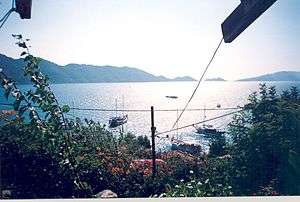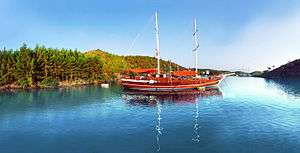Blue Cruise

A Blue Cruise, also known as a Blue Voyage (Turkish: Mavi Yolculuk) or Blue Tour (Turkish: Mavi Tur), is a term used for recreational voyages along the Turkish Riviera, on Turkey's southwestern coast along the Aegean and Mediterranean seas.[1] The cruise allows participants to enjoy a week-long trip aboard the iconic local gulet schooners to ancient cities, harbors, tombs, mausolea, and intimate beaches in the numerous small coves, lush forests, and tranquil streams that lace the country's Turquoise Coast.
Carian Cruise is a lesser-known synonym used by some sources internationally, in reference to the term Caria — the name this region of southwest Turkey was called in ancient times.
History
The term Blue Voyage, which is used in Turkey's tourism industry, has its origins in Turkish literature, deriving from the title of a book by Azra Erhat,[2] and was first introduced into Turkish literature by a handful of writers, such as Cevat Şakir Kabaağaçlı (alias The Fisherman of Halicarnassus).[3] The author, who had been exiled to Bodrum in 1925, began taking trips with his friends on the local sponge divers' sailing boats, called gulets, and was deeply moved and inspired by the local culture and natural beauty. These excursions became known as "Blue Voyages".
Fellow author Sabahattin Eyüboğlu, together with his circle of family and friends, participated in Blue Cruises,[4] as did Azra Erhat. The literary review "Yeni Ufuklar" (New Horizons) in the 1950s and 1960s contributed to publicizing and popularizing the Blue Cruise, and numerous guidebooks were published in Turkish [5] and German[6] presenting romantic depictions of the voyage, which has since grown to become a popular national and international phenomenon supporting a sizable portion of the local economy, and is regarded as responsible for transforming Bodrum from a sleepy fishing village to a global holiday destination, as well as popularizing the Turquoise Coast itself.
Routes
The voyage is taken by national and international tourists from around the world, and is particularly popular with visitors from Italy.[7]
Different chartered boat companies offer different routes that are both standardized and catered to the individual needs of specific tour groups. The routes can be as short as traveling to a couple secluded coves nearby larger towns for a couple days, or can be as extensive as traveling the entire length of the Turkish Riviera across several weeks. There are options to start a voyage in the Turquoise Coast including Bodrum, Marmaris, Fethiye and Antalya en route to the smaller villages and coves like Dalyan, Gökova, Kekova, and similar destinations, which constitute the more popular portions of the route. It is also possible to visit Greece, and surrounding Greek islands.
See also
References
- ↑ Holliday, Taylor (July 2, 2006). "Where to Raise the Sails, or Just a Glass". New York Times. Retrieved 18 May 2011.
- ↑ Erhat, Azra; Gültekin Çizgen (2005). Mavi yolculuk: gezi (in Turkish). Galatasaray, İstanbul: Can Yayınları. ISBN 978-975-07-0446-8.
- ↑ Whiting, Dominic (2001). Turkey Handbook. Footprint Handbooks. p. 315. ISBN 978-1-900949-85-9.
- ↑ Eyuboğlu, Bedri Rahmi (2008). Mavi yolculuk defterleri. Türkiye İş Bankası Kültür yayınları (in Turkish). 1630. İstanbul: Türkiye İş Bankası Kültür Yayınları. ISBN 978-9944-88-541-6.
- ↑ Özükan, Bülent (2005). Mavi yolculuk = Blue voyage (in Turkish). İstanbul: Boyut Yayın Grubu. ISBN 978-975-521-778-9.
- ↑ Hengirmen, Mehmet (2000). Die blaue Reise: mit 201 Fotos des Verfassers und 122 Karten = Mavi yolculuk (in German). Ankara: Eğitim ve Kalkınma Vakfı. ISBN 978-975-96804-3-5.
- ↑ Kaylan, Melik (May 15, 2011). "Land of Promise, Land of Loss". Newsweek. Retrieved 19 May 2011.
Further reading
- Erhat, Azra; Gültekin Çizgen (2005). Mavi yolculuk: gezi (in Turkish). Galatasaray, İstanbul: Can Yayınları. ISBN 978-975-07-0446-8.
- Özükan, Bülent (2005). Mavi yolculuk [Blue voyage] (in Turkish). İstanbul: Boyut Yayın Grubu. ISBN 978-975-521-778-9.
